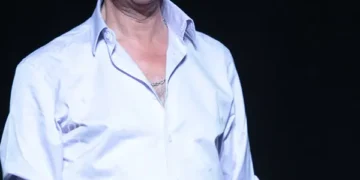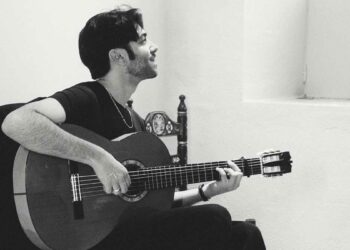|
The final night of the Madrid festival, and all sold out,
the Albéniz theater was symbolically turned into the Villamarta
Theater of Jerez. Singers Capullo de Jerez and Manuel Moneo, and
dancer Antonio el Pip – a good strong program for the last
night.

de la Tota comes on stage and sits on the cajón, Tequila
de Jerez gets settled in to do palmas and the occasional chorus,
Diego Amaya with his guitar….and Capullo de Jerez. They begin
with soleá, with a strongly marked compás, and Capullo’s
powerful stylized rough voice. Fandangos in his special way leads
to a medley of tango styles where the singer’s complete command
of the rhythm is notable. Miguel Flores indulges in the conceit
of deliberately going out of compás, to then put it all back
together (not an easy task), beginning and ending with his “esto
no es vivir” and presenting potential future items for a recording
such as “no me gusta el pan” and “la culpa no
la tuve yo”. Diego Amaya’s guitar is full of compás
and brings applause again and again. Some artful bulerías,
verses that tell us Alejandro Sanz is a heart-breaker and a version
of Camarón’s “Dicen de mí”. Ovations
and applause for Capullo at his best, ending away from the mike
and serving up his little dance. His performance felt short and
left us wanting more, but that’s how it is in a festival and
all the artists must have their moment.
To get a bead on the future, you have
to look to the past

Moneo came on with a friendly countenance and was prepared to win
the audience over. Both Manuel and his son Juan on the guitar offered
a repertoire firmly anchored in Jerez of the last few decades, not
a very original approach perhaps, but we need artists such as these
who conserve the forms because to get a bead on the future, you
have to look to the past. A well-executed soleá, siguiriyas
that included an especially interesting guitar variation, fandangos
and bulerías. To finish, the typical fiesta finale with the
three palmeros from Jerez and the guitarist’s delightful dance.
This took us up to the intermission.
The show that brought the most applause
at the 12th Caja Madrid Festival

said it before and I’ll say it again: Antonio el Pipa is a
ray of light. A bright white impact when the curtain goes up, Antonio
dances to the sound of his own style, his body does bulerías
that needs no other instruments to be understood. Softly and slowly
the guitar begins to sound, until it turns clearly into bulerías
with the whole group in high gear. This is followed by Juana la
del Pipa who takes center stage to sing some tangos with her characteristic
gravel voice, and Antonio appears dressed in a black bullfighter’s
costume. His alegrías is more feet than hands, and he gently
slices the air with each movement while Juana provides the cante.
Enrique el Extremeño, a singer who has not had the recording
success he deserves, sings verses that speak of Joaquín el
de la Paula paying tribute to his Alcalá style of cante.
Another high point of Enrique’s performance came when he sang
a verse that spoke of mourning the absence of Pastora, Pinto and
Tomás in Seville’s Campana. Turning then to the dancer,
we observe as María José Franco begins moving to the
compás of soleá with a dance that is feminine and
carefully-executed. The audience reacts enthusiastically and at
this point this is the show that has been best-received in the festival.
The soleá moves into bulerías and leads to siguiriya.
The customary tandem between Antonio and his aunt Juana brings a
warm reaction and the final bow is hailed with a standing ovation.
Antonio el Pipa’s show is the one that brought the most applause
at the 12th Caja Madrid festival, and now all that’s left
is to wait and see what next year will bring.
Haga click sobre las fotos para ampliarlas

en el escenario Luis de la Tota que se sentará en el cajón,
Tequila de Jerez dispuesto a tocar las palmas y hacer algún
coro, Diego Amaya con su guitarra… y el Capullo de Jerez. Comienzo
por soleá, con un compás bastante bien marcado, voz
potente y rota a su peculiar estilo. Fandangos también de
estilo personal, para irse a un popurrí de tangos en los
que el dominio de la esencia rítmica se hace patente. Miguel
Flores se permite el lujo de irse del compás para volver
sobre él (cosa nada fácil), y comenzando y terminando
con “esto no es vivir”, nos presenta futuros temas discográficos
como “no me gusta el pan” o “la culpa no la tuve
yo”. Diego Amaya toca su guitarra con mucho compás,
lo cual provoca algún que otro aplauso.Bulerías con
arte, las letras en que afirma sobre Alejandro Sanz que parte corazones,
y una versión del “Dicen de mí” camaronero.
Aplausos y ovaciones para un Capullo con arte que terminó
cantando sin micrófono y echándose su pataíta
correspondiente, su actuación se hizo corta y nos dejó
con ganas de más… pero el festival es así y hay
que repartir el tiempo.

Moneo entró con simpatía y actitud de ganarse al público.
Tanto Manuel como su hijo Juan a la guitarra hicieron un repertorio
anclado en todos los conceptos en un Jerez de hace varias décadas,
quizás pueda resultar una apuesta poco original y vetusta,
pero también se hace necesario que haya artistas así
que conserven ciertas formas puesto que para mirar bien al futuro
hay que tener referencias del pasado. Una soleá bien cantada,
unas seguiriyas con una falseta de guitarra bastante interesante,
fandangos, y bulerías. Al final, típico fin de fiesta
con los tres palmeros jerezanos y baile con gracia del guitarrista.
De este modo se dio paso al descanso.

es la primera vez que lo digo, Antonio el Pipa es luz. Impactantemente
blanco al abrirse el telón, Antonio baila al compás
del sonido de su propio aire, su cuerpo hace sonar la bulería
que no necesita más instrumentos para ser escuchada. Despacito
va entrando el sonido suave de la guitarra, hasta ir derivando en
una bulería con todo el grupo en acción. Posteriormente
de un momento de protagonismo para Juana la del Pipa cantando tangos
con su característica voz profunda, sale Antonio de nuevo
vestido de negro con esencia torera. Alegrías con más
pies que manos, en las que rompe suavemente el aire con cada movimiento,
y Juana canta con gusto. Enrique “el Extremeño”,
cantaor que aún no ha tenido un merecido éxito discográfico,
habla en sus letras de Joaquín el de la Paula haciéndole
homenaje con su estilo de cante alcalareño. Destacable además
otro momento de Enrique en la actuación en que afirma llorar
por no ver a Pastora, Pinto y Tomás en la Campana sevillana.
Volviendo al bailaor jerezano, se mueve por soleá entrando
en escena María José Franco con un baile muy femenino
y bastante cuidado. El público desde las gradas ovaciona
y aplaude, el espectáculo está comenzando a ser lo
más destacable del festival a estas alturas. La soleá
se convierte en bulería para pasar posteriormente a la seguiriya.
Se produce el ya habitual encuentro entre Antonio y la tía
Juana que provoca sentimientos entrañables, y todo va sucediendo
de tal manera que el publico despidió el evento en pie y
de manera triunfal. El baile de Antonio el Pipa ha sido el espectáculo
con más aplausos en el XII Festival Flamenco Cajamadrid,
ahora toca esperar que nos ofrecerá la organización
para la próxima edición.
| Haga click sobre las fotos para ampliarlas |
||||
Fotografías: Rafael Manjavacas
|
|
Todas las Reseñas XII Festival Flamenco Caja de
Madrid.




























